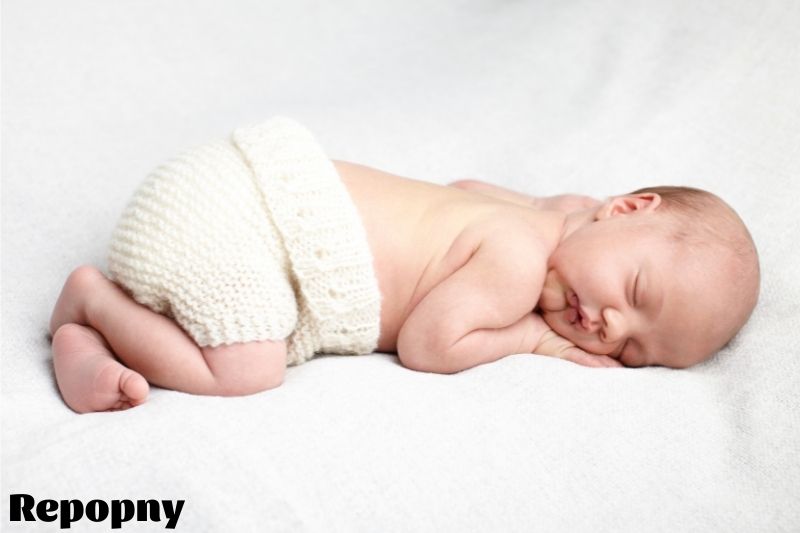- Repopny
When can babies sleep on their stomachs? This is a question that many parents ask. The answer may surprise you. Most babies can start sleeping on their stomachs when they are around 4 months old.
However, some babies may not be ready to sleep on their stomachs until they are 6 or 7 months old. If you are unsure if your baby is ready to sleep on their stomach, you can ask your pediatrician for advice.
Contents
- 1 Official Sleep Recommendations
- 2 But How Long Do You Have To Keep These Recommendations Up?
- 3 Can You Tell Me Why This Is The Case?
- 4 Benefits Of Your Baby Sleeping on Their Stomach
- 5 Risks of Your Baby Sleeping on Their Stomach Too Soon
- 6 What If Your Infant Falls Asleep On Their Tummy Before Turning One Year Old?
- 7 What If Your Baby Won’t Sleep Unless They Are Lying Down On Their Stomach?
- 8 Conclusion
Official Sleep Recommendations
The American Academy of Pediatrics (AAP) issued a clear policy statement on safe sleep recommendations in 2016 to help prevent SIDS. Placing the infant is one of them.
- a complex, level surface
- backward
- without any extra cushions, sheets, blankets, or toys in the crib or bassinet
- a room that is shared (not a shared bed)
These guidelines apply to all types of sleep, including naps and nighttime sleep. The American Academy of Pediatrics also suggests utilizing a crib or other distinct surface free of bumper pads, which were once considered a safety feature but are no longer.
But How Long Do You Have To Keep These Recommendations Up?
What exactly qualifies as a baby is a million-dollar question.
1 year is the quick answer. In children with no health difficulties, the risk of SIDS declines considerably after a year. Your baby can have a light blanket in their crib at this point.
The longer answer is that you should continue to place your kid in a crib on their back for as long as possible. That does not imply that they must remain thus. It’s fine if kids sleep on their stomachs before turning one year old. In a moment, I’ll go over that.
Can You Tell Me Why This Is The Case?
Following the rules — placing the bed in a less-than-comfortable location, away from mom’s warm embrace, and without any comfort items — seems counterintuitive.
However, the research shows that these suggestions are linked to a lower incidence of SIDS, which occurs between 2 and 4 months.
In 1992, the American Academy of Pediatrics (AAP) issued its first sleep recommendations, and in 1994, the “Back to Sleep” campaign, now known as the “Safe to Sleep” initiative, was launched.
SIDS deaths have reduced since the early 1990s, falling from 130.3 per 100,000 live births in 1990 to 35.2 per 100,000 live births in 2018.
Why is it that sure babies seem to enjoy belly napping so much? Researchers aren’t clear why it raises the risk of SIDS.
According to specific research, a baby’s upper airway can get obstructed when breathing in their own exhaled breath. Carbon dioxide builds up, and oxygen levels decrease due to this.
Inhaling your own exhaled air can make it difficult for body heat to leave, leading to overheating. (Overheating, but not sweating, is a proven risk factor for SIDS.)
The irony is that a belly-sleeping infant sleeps longer and is less sensitive to noise, which every parent desires.
However, the precise purpose that parents are pursuing makes it harmful. Blood pressure and heart rate control both drops dramatically in belly sleepers.
It’s reasonable to assume that if a baby falls into lighter sleep frequently and does not appear to enter the unbroken sleep cycle that we desire, they are doing fine (and for their tired parents).
Breaking Myths
One persistent myth is that putting a baby on their back can cause them to aspirate their vomit and stop breathing. This has been debunked, and back sleeping may even have some health benefits, such as reduced risks of ear infections, stuffy noses, and fever.
Parents are often concerned about muscle development and flat patches on the head, although everyday tummy time can help with these issues.
Benefits Of Your Baby Sleeping on Their Stomach
It’s no surprise that many newborns prefer to sleep on their backs. They’re on to something, at least intuitively.
More Comfortable
If your kid has started sleeping on their stomach, there’s a good chance they enjoy it. Becker Freidman adds, “It’s fairly common for babies to roll onto their stomach during sleep.” “It’s more pleasant for many people than lying on their backs.”
Don’t turn your baby over or use an infant positioner or nest if they still seem unhappy on their back. Becker Freidman warns, “These are not safe and have been linked to baby deaths.” Limiting your baby’s carrying or wearing during naps will help them become accustomed to sleeping on their back.
Sleep Cycles That Might Be Longer
According to Becker Friedman, babies that sleep naturally on their stomachs sleep for more extended periods. Premature babies, in particular, have been demonstrated to sleep for longer lengths of time in the prone position.
Risks of Your Baby Sleeping on Their Stomach Too Soon
Placing your infant on their stomach to sleep too young is against medical advice, but it can also be dangerous.
SIDS
Although it has not been shown that stomach sleeping causes SIDS, it is a risk factor during the first six months of life, when infants are susceptible.
The American Academy of Pediatrics Task Force on Sudden Infant Death Syndrome is unequivocal in its anti-stomach sleeping recommendations, citing a substantial link between stomach sleeping and SIDS.
According to the National Institutes of Health, countries that have started programs encouraging parents to put their kids to sleep on their backs have experienced a considerable reduction in SIDS prevalence.
According to Becker Freidman, doing up to 30 minutes of tummy time per day will help your baby build neck, shoulder, arm, and back strength—all of the muscles required to roll back to front and front to back independently. “A baby’s nose and mouth will be face down on the mattress, allowing them to turn to the side, move about, and breathe easily.”
Suffocation
According to Dr. Murray, if a baby with poor head control turns onto their stomach, they may restrict their airways, posing a suffocation danger. The reason pediatricians don’t recommend stomach sleeping or propping a baby up on their side is that it may encourage them to roll over.
As a result, around 12 weeks of age, or sooner if they begin to show signs of rolling, you should remove your child’s arms from their swaddle or convert them to a sleep sack that doesn’t constrain their upper body.
“If a baby is swaddled past the point of rolling, they may wind up face- and nose-down on the mattress, unable to squirm to a free-breathing posture,” Becker Freidman warns, adding that weighted sleepsuits offer the same dangers to rollers.
Rebreathing
According to Becker Freidman, when newborns sleep on their stomachs, they may try to rebreathe air that has become caught in the bedding, resulting in carbon dioxide build-up and low oxygen levels.
As a result, she claims, most newborns will wake up and breathe fresh air before being well. However, some newborns will be slower to respond or will be unable to roll over, losing consciousness due to rebreathing, which is one reason why rebreathing is thought to be a SIDS trigger.
Overheating
According to research, low-birthweight babies’ ability to emit heat and control body temperature may be harmed by stomach sleeping.
This could result in hyperthermia, which is another SIDS risk factor.
Dress your baby in a lightweight wearable blanket, keep their head and face uncovered, and keep an eye out for indicators that your baby is overheating. Remove a layer or change the thermostat if they are sweating or feel hot when you touch their chest. 8
Obstruction of the upper airway
Many parents believe that newborns who sleep on their stomachs are less prone to aspirate or mistakenly breathe fluid into their lungs if they spit up. According to Becker Freidman, however, the opposite is true. “Back sleepers are far less prone to aspirate if they spit up because of the configuration of the trachea and esophagus,” she explains.
What If Your Infant Falls Asleep On Their Tummy Before Turning One Year Old?
Possibly though, your baby will be able to roll over both ways spontaneously at 6 months old — or even earlier — the rules recommend that you continue to put them to sleep on their back until they’re one year old. It’s usually fine to let your child sleep in this posture once this has happened.
This is usually around when SIDS peaks, while there is still a danger until the child turns one.
Before leaving your baby in their favorite sleeping position, make sure they are rolling over consistently, from the stomach to back and back to the tummy.
If they aren’t constantly and consciously rolling yet but end up on their stomach while sleeping, you must gently place them back on their back, no matter how difficult it may be. Hopefully, there won’t be too much agitation.
What If Your Baby Won’t Sleep Unless They Are Lying Down On Their Stomach?
Harvey Karp, a doctor and author of “Happiest Baby on the Block,” has become a prominent proponent of safe sleep while educating parents on getting a (semi) peaceful night.
Swaddling, advocated by Karp and others, simulates the close quarters of the womb and may prevent babies from waking up throughout the night.
A Word About Swaddling Your Baby Safely
Swaddling has recently resurfaced in popularity, but it can cause overheating and hip problems if done poorly. Follow these instructions in addition to placing a swaddled infant on their back in a safe sleep environment free of blankets, pillows, and toys:
- Once your baby can roll over, stop swaddling them and replace him with a sleeping bag that allows you to have your arms free.
- In warmer temperatures, avoid swaddling and be aware of the indicators of overheating (rapid breathing, flushed skin, sweat).
- Make sure three fingers separate your baby’s chest and the swaddle.
- Karp also suggests utilizing a sound machine to mimic the womb for naps and sleep.
He’s discovered that swaying, swinging, and shushing babies in the side and stomach positions soothes them, so he’ll keep them in those postures (but not for actual sleep).
Karp’s methods reveal that sleeping on one’s stomach, along with his other strategies, activates soothing systems in babies as young as three months old, which explains why some babies prefer to sleep on their stomachs. Put your infant to bed on their back once quiet and asleep.
Consult Your Doctor
We don’t know how many parents put their newborns to sleep on their stomachs because it appears to be a taboo topic. However, online discussion boards indicate that it might be a significant amount.
You’re exhausted — and that’s a significant matter that shouldn’t be overlooked — but sadly, the method your kid prefers to sleep isn’t the greatest if it entails belly sleeping until they can roll over (both ways) independently.
Your physician is available to assist you. Discuss your concerns with them; they may be able to offer advice and solutions to help you and your baby sleep better and more comfortably.
Allowing your child to slumber on your chest isn’t intrinsically dangerous if you’re awake and vigilant, as long as you don’t fall asleep or become distracted.
But, let’s face it, as new parents, we’re prone to dozing asleep. And baby can unexpectedly roll off of you.
Parents can also assist in ensuring sleep safety by:
- Use a pacifier if your child is having trouble sleeping.
- if you can, breastfeed
- make sure the infant isn’t too hot
- Keep the infant in your room for the first year of life (not on your bed).
A Word Of Caution
While feeding or sleeping, sleep positioners and wedges are not advised. The Food and Drug Administration does not recommend these padded risers because of the danger of SIDS.
Your baby cries at night, this guide maybe help: Why Do Babies Cry In Their Sleep?
Conclusion
A few other tips to remember are to teach your baby how to roll over. Tummy time is a great way to develop muscles in the back, legs and neck while helping prevent flat spots (bloating) on the back.
Babies can practice rolling to their tummies while lying on their backs. Repopny hopes this guide is useful for you.







